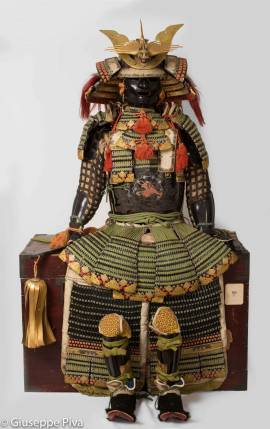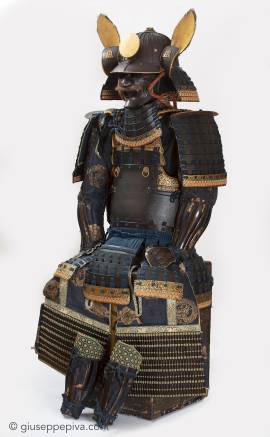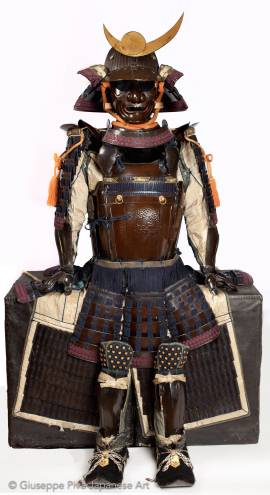Samurai armor bearing the kamon of Inaba familyMid to late Edo period (1615 - 1867)Kabuto bachi signed “Masuda Myochin Minbu Ki no Munesada Saku” and dated February 1757Provenance:Iyo no kami Inaba clan This very important authentic samurai armor is complete and original. It is entirely made of hon-kozane plates (individual scales) and bears gilt metal engraved kanamono all over its parts; interiors are lacquered in gold, a sign of a very high level provenance.The armor comes with a wide series of accessories: it includes two pairs of suneate (one heavier and one very...
WORKS FOR SALE
Tsutsumi-dō tosei gusokuSamurai Armor with leather-covered cuirassKaga schoolMid Edo period, 18th-19th century This authentic samurai armor features two characteristics that can be often found on suits made in the region of Kaga: the leather surface and the different color of the last plates. The whole surface, except for the kabuto bachi and the mask, is in fact covered with black leather. The use of leather instead of lacquer to protect the iron surface is something seen very often on Kaga armor, as well as the scattered gilt surface of the last plate of each element. The...
Samurai armor in Sendai styleKabuto signed: Myochin Ujiie saku and dated August 1527 PERIODMid Edo period (1615-1868), 18th centurySIGNATUREMyochin Ujiie saku EXHIBITIONS"Samurai - Passato e Presente", Novara 2012LITERATUREG.Piva - S. Verrina, Samurai - Passato e Presente, cat. A3, Novara 2012 The helmet (kabuto) of this authentic samurai armor incorporates on an older bowl (bachi) signed by Myochin Ujiie, an armorer documented in the official Myochin genealogies as second son and pupil of the famous Smith Nobuie. Among the typical...
Copyright © 2016 - giuseppe piva - VAT: 05104180962










